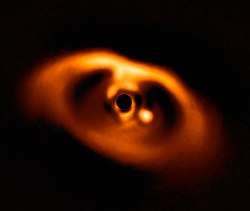Tidally detached exomoon
Tidally detached exomoons, also known as orphaned exomoons[1] or ploonets,[2] are hypothetical exoplanets that were formerly exomoons of another planet, before being ejected from their orbits around their parent planets by tidal forces during planetary migration, and becoming planets in their own right.[3][4] As of 2019, no tidally detached moons have yet been definitively detected, but they are believed to be likely to exist around other stars, and potentially detectable by photometric methods. Researchers at Columbia University have suggested that a disrupting detached exomoon may be causing the unusual fluctuations in brightness exhibited by Tabby's Star.[5]
The "charmingly goofy" term "ploonet", used in a paper published in the Monthly Notices of the Royal Astronomical Society,[2][6] has received attention from mainstream media sources.[2][7][8][9]
References
- Metzger, Brian D.; Stone, Nicholas C.; Martinez, Miguel (20 June 2019). "Orphaned Exomoons: Tidal Detachment and Evaporation Following an Exoplanet-Star Collision". Monthly Notices of the Royal Astronomical Society. 489 (4): 5119. arXiv:1906.08788. Bibcode:2019MNRAS.489.5119M. doi:10.1093/mnras/stz2464.
- Starr, Michelle (10 July 2019). "Scientists Are Trying to Make 'Ploonets' a Thing, And We Are Here For It". ScienceAlert. Retrieved 12 July 2019.
- Sucerquia, Mario; Alvarado-Montes, Jaime A.; Zuluaga, Jorge I.; Cuello, Nicolas; Giuppone, Cristian (27 June 2019). "Ploonets: formation, evolution, and detectability of tidally detached exomoons". Monthly Notices of the Royal Astronomical Society. 489 (2): 2313. arXiv:1906.11400. Bibcode:2019MNRAS.489.2313S. doi:10.1093/mnras/stz2110.
- Grossman, David (10 July 2019). "They're Not Moons. They're Not Planets. They're Ploonets". Popular Mechanics. Retrieved 12 July 2019.
- Starr, Michelle (18 September 2019). "There's a New Explanation For Mysterious Tabby's Star: A Melting Ploonet". ScienceAlert. Retrieved 19 September 2019.
- Sucerquia, Mario; Alvarado-Montes, Jaime A.; Zuluaga, Jorge I.; Cuello, Nicolas; Giuppone, Cristian (27 June 2019). "Ploonets: formation, evolution, and detectability of tidally detached exomoons". Monthly Notices of the Royal Astronomical Society. 489 (2): 2313–2322. arXiv:1906.11400. Bibcode:2019MNRAS.489.2313S. doi:10.1093/mnras/stz2110.
- Kooser, Amanda (10 July 2019). "Ploonets, hell yeah. Runaway moons get a charmingly goofy name". CNET. Retrieved 12 July 2019.
- Whyte, Chelsea (4 July 2019). "Exomoons that run away from their planets could become 'ploonets'". New Scientist. Retrieved 12 July 2019.
- Strickland, Ashley (17 July 2019). "Wandering moons called 'ploonets' could be the culprits behind astronomical mysteries". CNN News. Retrieved 17 July 2019.
See also
- Exoplanet – Any planet beyond the Solar System
- Exomoon – Any moon beyond the Solar System
- Kozai mechanism – dynamical phenomenon affecting the orbit of a binary system perturbed by a distant third body
- Poynting–Robertson effect – process in which solar radiation causes a dust grain orbiting a star to lose angular momentum
